Text
i need people do do me a favor and be absolutely normal about it
29K notes
·
View notes
Photo
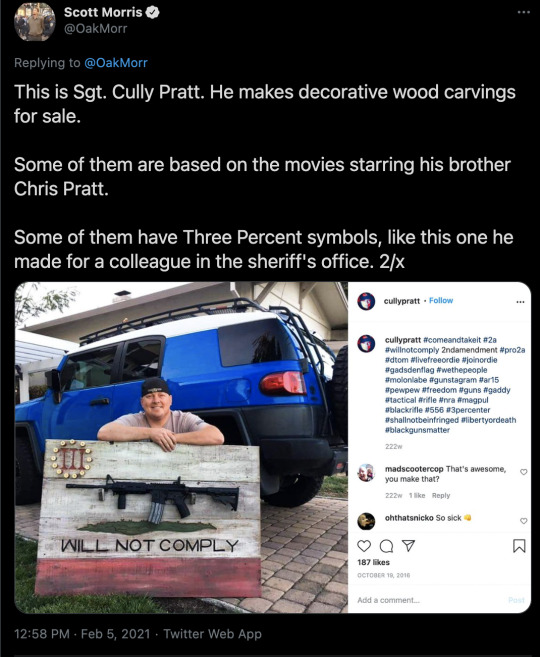

i haven’t seen anyone on tumblr talking about this and i think we need to
78K notes
·
View notes
Text
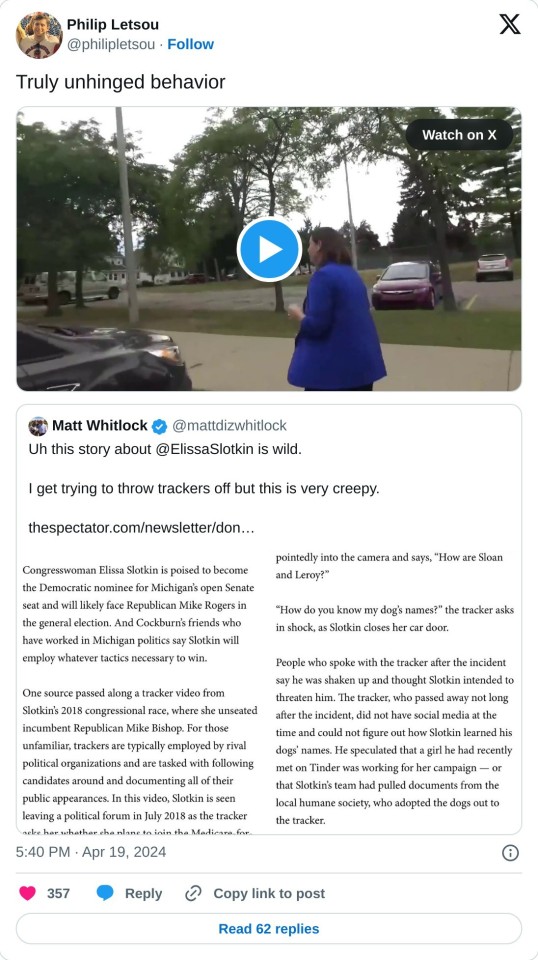
Probably a distinctly American thing but we have a thing called trackers.
Which are basically people your opponent has hired to follow you around in your campaign and bait you record all your speeches etc.
This is Elissa Slotkin when she was running for congress.
Elissa Slotkin is ex-CIA.
Elissa Slotkin just casually asked the dude who’s following her how his dogs Sloan and Leroy are doing.
288 notes
·
View notes
Note
I get that a lot of members of the American right want a war with Iran, especially people in Congress. What I don't understand, though, is /why/. What's the history of these tensions between the USA and Iran? I imagine it stems from the American-backed coup after Mosaddegh nationalized the oil industry, but what developments happened between then and now to cause so many America to want war this badly?
I cover this in my article; it’s a bit of a lengthy read, but this is my best explainer for the history behind current US-Iranian relations.
In 1951, a large majority of the Iranian parliament nominated Mohammad Mosaddegh as the nation’s new Prime Minister. His nomination was accepted by Iran’s king (referred to as a Shah), Mohammad Reza Pahlavi. As Prime Minister, Mosaddegh sought a progressive secular agenda within Iran’s democratic political system: he introduced workers’ protections, created new public services, advocated for further democratic reforms, and fought for the rights of women. Most controversially, though, he nationalized the Anglo-Iranian Oil Company (AIOC), the company through which the British controlled the nation’s oil resources, in order to prevent foreign domination and ensure that Iran had full control over its own wealth.
The UK was not a fan of this move. British intelligence convinced the CIA that the removal of Mosaddegh was an imperative both to secure Iranian oil for the West and to prevent Iran from turning to the Soviets- largely a false concern. In 1953, the CIA and British M16 launched Operation Ajax, which recently declassified documents from the CIA describe as a “military coup that overthrew [Mosaddegh] and his… cabinet… carried out under CIA direction as an act of U.S. foreign policy, conceived and approved at the highest levels of government.” Iranian democracy collapsed, the Shah and his new appointees took full power, and the AIOC changed its name to what it’s known as today: BP.
Though Iran’s new government instituted a handful of progressive modernizing reforms, it was essentially a dictatorship seeking to suppress public frustration. It worked, until it didn’t. In 1979, a popular movement under the reactionary theocratic leadership of Ruhollah Khomeini successfully overthrew the government, along with holding Americans at the US embassy hostage in a tense standoff for over a year. Though the various groups constituting the movement, from leftist student groups to conservative Islamists, disagreed about what they wanted Iran to be and which parts of Western modernization were objectionable, all of them opposed the Shah, who was seen as a corrupt autocrat who served as a puppet to Western powers. Following a brief power struggle, Khomeini took control of Iran as Supreme Leader, launching the current Iranian government.
Western powers sought any way they could to take down this new anti-Western theocracy. In 1980, Iraq took advantage of the turbulence in Iran to invade the country, seeking to replace it as the dominant power in the Middle East. The US, the UK, France, West Germany, Saudi Arabia, and even the Soviet Union all lined up to support the brutal warfare of Iraq’s leader, Saddam Hussein. Hundreds of thousands died, if one includes the genocidal Al-Anfal campaign that Saddam undertook against Iraqi Kurds. Years later, in 2014, the New York Times would drop the bombshell story that there were indeed weapons of mass destruction found in Iraq- they were chemical weapons left over from the Iran-Iraq War, and were “designed in the United States, manufactured in Europe and filled in chemical agent production lines built in Iraq by Western companies.”
During the war, Iran began its strategy of providing support to ideologically sympathetic terrorist organizations in order to build support among regional proxy groups such as Hezbollah and the Islamic Jihad Organization. In 1983, the latter group bombed the US embassy in Lebanon, killing 63 and wounding another 120.
In 1988, just a few months before the war would end, the US Navy would accidentally misidentify an Iranian passenger plane as a military fighter jet and shoot it down while it was still in Iranian territory. Iran Air Flight 655 was destroyed, killing 290 civilians, including 66 children.
Understandably, relations between the US and Iran remained unfriendly even after the war ended and Iran began to rebuild its power in the region. Iranian hostility towards the United States was not blind, however. After 9/11, many al Qaeda operatives fled across the border from Afghanistan to Iran. Rather than providing them protection or even celebrating them, Iran rounded them up, made copies of their passports, and detained or expelled them. Through the UN, Iran then gave the copies of the passports to the US in order to help them identify the terrorists, and also allowed US officials to interrogate some of the ones being detained. James Dobbins, Chief Negotiator on Afghanistan for the Bush administration at the time, said that the Iranians were “comprehensively helpful.”
While Iran cooperated with the US in their invasion of Afghanistan, post-9/11 efforts to thaw relations generally fizzled out with little success. The Iranians instead decided to go their own way, utilizing the vacuums in regional power produced by the Iraq War to extend their political reach into Iraq, Syria, Lebanon, and more. Indeed, the Iraq War provided such an opening for Iran to grow in influence that a recent report commissioned by the US Army itself stated that “an emboldened and expansionist Iran appears to be the only victor” of the conflict.
While they were already foes for reasons I’ve described before, this set up the currently-ongoing cold war between Iran and the region’s other major player, Saudi Arabia. Because the Saudis are long-standing close allies of the US, this raised tensions further. The issue of an Iranian nuclear weapons program lingered heavily on the minds of every party involved. Indeed, it so worried America and Israel that they jointly launched one of the most successful cyberattacks ever conducted on Iran’s nuclear infrastructure.
But after years of such high tension under the reign of the hardline President Mahmoud Ahmadinejad, Iranian voters elected the more moderate Hassan Rouhani in 2013. Though the Iranian presidency is a position with limited power- the Supreme Leader makes the final decisions- this softening of Iran’s positions allowed for the negotiation of a highly successful nuclear deal with the Obama administration.
Despite Iran’s full compliance with the agreement, the Trump administration announced that it planned to cease compliance with the agreement. Breaking with European allies, the Trump administration has begun rapidly ratcheting up sanctions and pointing guns in Iran’s direction.
On May 21st, 2019, Secretary of State Mike Pompeo posted a Tweet accusing Iran of “40 years of unprovoked aggression.”…
The current US conflict with Iran can be essentially boiled down into two contentious issues- the Iranian nuclear program and Iran’s aggressive expansion of its influence across the region.
Iran first started its nuclear program with the goal of civilian energy production with the help of Western powers while the Shah was still in control of the nation. The program continued even after the 1979 revolution, however, with the new Iranian government recognizing not only the potential of nuclear energy, but also that developing a nuclear weapon could serve as a deterrent against any further aggression, giving the nation a uniquely powerful card to play in the region. Iran seeks development of a nuclear weapon for the same reason that North Korea does: to ensure against external attack through mutually-assured destruction.
This prospect terrified the West almost immediately. The authoritative US publication Jane’s Defense Weekly reported in 1984 that the Iranians were working on a nuclear bomb that was “likely to be ready within two years.” In the following three decades, US and Israeli intelligence officials have been almost constantly issuing warnings and raising alarms about an imminent Iranian nuclear weapon that never seemed to actually come.
But though the fearmongering surrounding Iran’s nuclear program was highly exaggerated, it remained true that Iran was working on the development of a nuclear weapon alongside its nuclear energy program, however slowly. For this reason, Obama and Rouhani, along with the other world’s leading powers, came together for an agreement with Iran (the JCPOA) which effectively put a stop to Iran’s weapon program and provided unprecedented access to international inspectors to ensure compliance. In exchange, some of the strict sanctions against Iran would be relieved- a much-needed concession meant to help the struggling Iranian economy.
The point of the agreement was solely to deal with the nuclear weapons issue, and it was successful in that regard- the International Atomic Energy Agency responsible for enforcement has consistently found that Iran is following the deal. Once this plan was successful, the original negotiators hoped, it would open the door for more comprehensive agreements with Iran to address other issues- namely, Iran’s support for proxy forces around the Middle East in order to expand its power and regional hegemony.
This is the second issue: Iran maintains a network of paramilitary proxies like Hezbollah which they use to advance their interests, many of which are involved in terrorism, and these proxies do play a destabilizing role in the region. Less commented on, of course, is that the same also applies to our ally Saudi Arabia, who maintains its own expansionist strategy via a global network of propaganda institutions, support for terrorist and separatist groups in Iran, and recently support for rebel organizations in Syria (including militant jihadists like the al-Qaeda spin-off al-Nusra). In their bid for regional hegemony, both parties play a role in actively upsetting Middle Eastern politics.
Conservatives only remember specific parts of this: the overthrow of the Shah, the US Embassy hostage crisis, the US Embassy bombing in Lebanon, the support for proxies and terrorist groups, the nuclear program, etc., while ignoring remaining context. They hate Iran because they see them as both a danger to the region and a threat to US power, a roadblock to US hegemony.
920 notes
·
View notes
Text
17K notes
·
View notes
Text
And the basis for how most of the industry operates comes from a cult that tried murdering a guy with a rattlesnake.
Their barbaric government operated reeducation camps versus our enlightened private institutions for troubled teens
4K notes
·
View notes
Text
Say what you will about the hypocrisy of the American revolution and constitution but even the 'Founding Fathers' recognized the importance of people having access to firearms as a check on state power. The British recognized it too, that's why their opening move was to try and disarm the colonial militias.
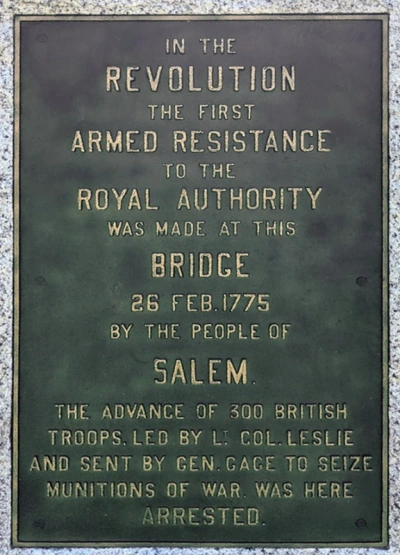
And thus the 2nd Amendment (and a tacky restaurant) was born a few blocks from my house.
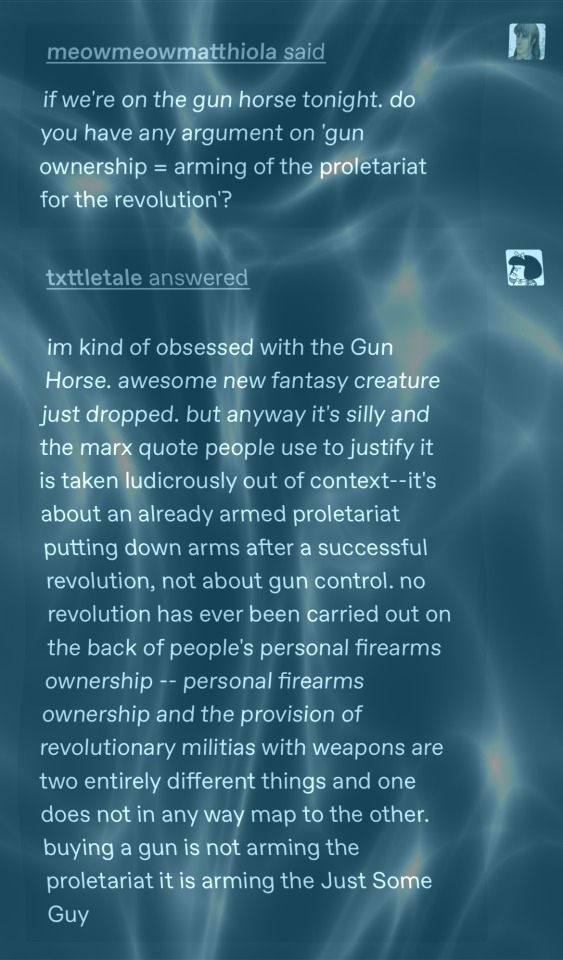
Gee I wonder how common private gun ownership was right before the Russian revolution? Oh wait it was actually common and civilians could easily buy firearms. Here’s a print ad from the time:
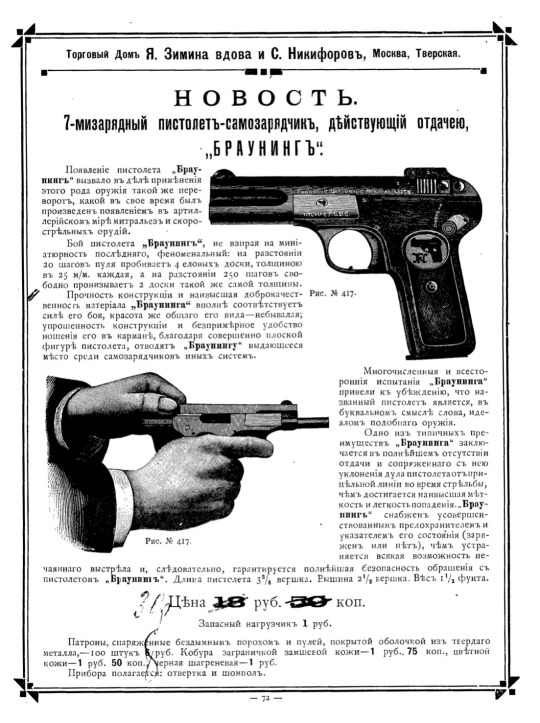
Historically, many revolutions and civil wars involved the use of privately owned firearms. A really common pattern that you see going back hundreds of years is that at the outbreak of conflicts, civilians would form militias, arm themselves with whatever they could get their hands on, storm government armories, and then steal everything not nailed down.
During the Yugoslav civil war, the UN enacted an arms embargo on all sides of the war from Sept 1991 through the end of the war. The VRS split off from the JNA, so they just took those weapons with them. However, the ARBiH had to acquire weapons from a lot of different sources, such as:
Stolen from JNA barracks
Stolen from Yugoslav police
Taken out of museums (Yes, really. They were literally using vintage captured MG42s from WWII)
Handmade (!) (Yes, really. I saw handmade guns that were used in the war on display in a museum in Sarajevo)
Smuggled in by Pakistani Intelligence Services (Specifically anti-tank missiles)
Picture: A group of ARBiH soldiers at the Old Bridge in Mostar, June 1992. The man on the far right is carrying a Winchester Model 70 (captured from a Serb, who purchased it in Montana)
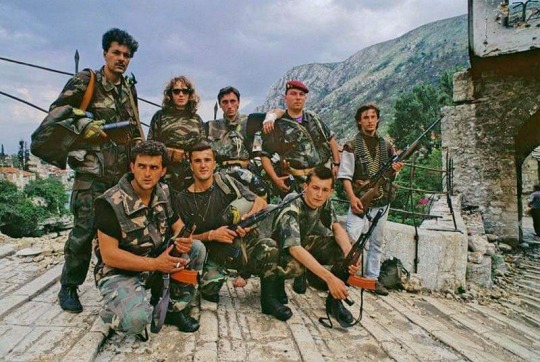
Picture: Two ARBiH soldiers, the one on the right is carrying an MG42.

Another conflict (or, more accurately, long series of conflicts) that we can also look to is the American Indian Wars. Native American combatants used a variety of weapons, but the weapons that they prized most highly were contemporary repeating rifles. Famously, repeating rifles such as the Henry lever-action rifle were contributing factors to the victory of Lakota and Cheyenne forces at the Battle of Little Bighorn in 1876. (Native Americans had been purchasing guns for hunting and combat for over a hundred years at that point. One of the earliest accounts of such a purchase was in 1750 where French traders traded flintlock muskets for horses from Wichitas and Comanches.)
Picture: The Apache military leader Geronimo, on right, accompanied by three younger warriors, 1886.
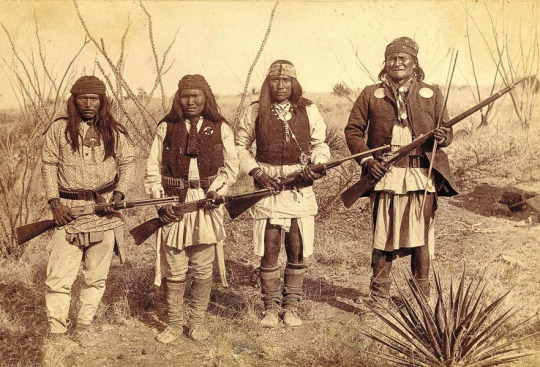
Let’s take another, ongoing example: The Myanmar civil war (2021- present, as of April 2024).
Fighters in the coalition of anti-junta forces use a wide variety of small arms, but most relevant for this post is the manufacturing and use of the FGC-9, a 9mm carbine compatible with Glock magazines.
(Side note: FGC stands for Fuck Gun Control.)
The FGC-9 design uses a combination of 3D-printed parts and easily-manufactured pressure-bearing metal parts.
Picture: a People’s Defense Force soldier carrying an FGC-9.
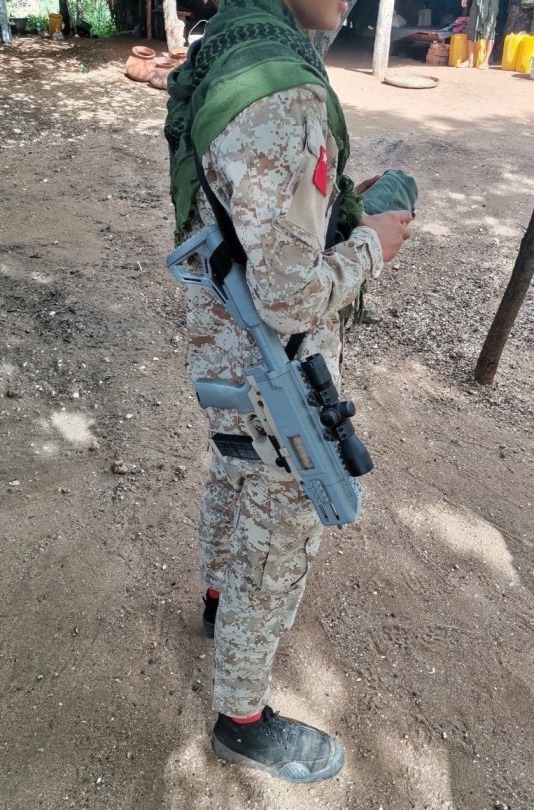
If you genuinely believe that there will be a revolution or civil war in your country in the future, then logically it is 100% reasonable to buy and train with guns right now.
If you genuinely believe that there will be a revolution or civil war in your country in the future, it makes absolutely no sense to hand-wave that away with “one day when the exact right circumstances emerge for a proletarian mass movement to Do Revolution, only then will we acquire even one single firearm. I’m just going to assume there won’t be massive obstacles such as arms embargoes, government crackdowns, or supply-chain issues that could completely stymie our ability to do that.”
If you genuinely believe that there will be a revolution or civil war in your country in the future wouldn’t it be better for the people on your side to already have some level of training & skill with firearms?
If you live in a country where the right wing has spent decades buying guns and salivating over the idea of starting a civil war and killing left-wingers and minorities, do you think it is a good idea to discourage left-wingers and minorities from buying guns?
#us politics#politics#gun control#Under no pretext should arms and ammunition be surrendered; any attempt to disarm the workers must be frustrated#by force if necessary
168 notes
·
View notes
Text
my favorite calvin and hobbes comic is the one where his dad just rolls up and casually destroys his entire night by pointing out some neat trivia about record players

164K notes
·
View notes
Text
Reblog to open a rail line from your blog to the person you reblogged this from

131K notes
·
View notes
Text

9K notes
·
View notes
Text

As of Apr 3, 2024
667 notes
·
View notes
Text
"There is almost no poc representation in space marines. They're mostly blonde haired blue eyed white guys!"
"AKSHUALLY there are more brunette white guys than blonde."
I think y'all've missed the forest and hit a tree.
Blah blah geneseed and all that but I think it would improve the game environment if there were space marines of color, yknow? No reason beyond big E being a white guy (and the fascism the game fails to properly criticize) for the elite genetically engineered fighting force to be all white dudes
390 notes
·
View notes
Text

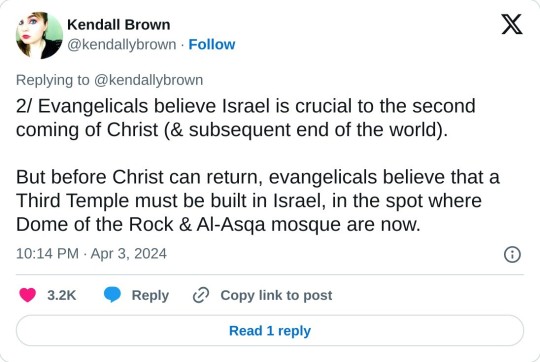
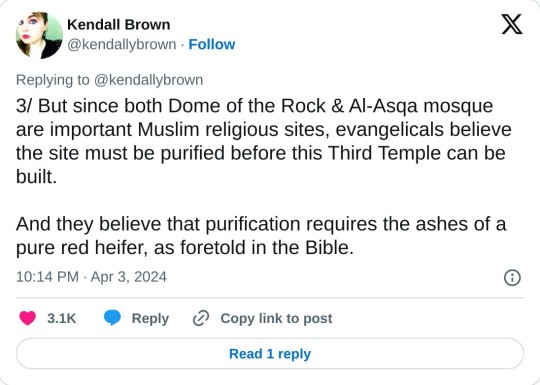
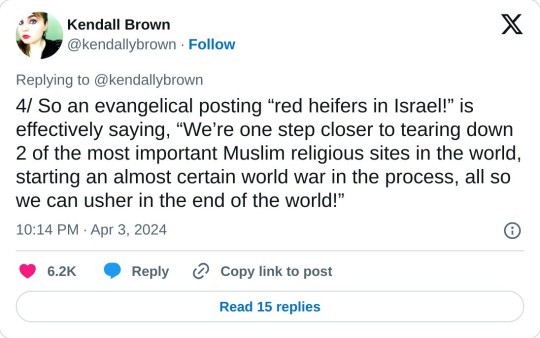

I cannot stand these reactionary Christian bitches
15K notes
·
View notes
Note
Rowling isn't denying holocaust. She just pointed out that burning of transgender health books is a lie as that form of cosmetic surgery didn't exist. But of course you knew that already, didn't you?
I was thinking I'd probably see one of you! You're wrong :) Let's review the history a bit, shall we?
In this case, what we're talking about is the Institut für Sexualwissenschaft, or in English, The Institute of Sexology. This Institute was founded and headed by a gay Jewish sexologist named Magnus Hirschfeld. It was founded in July of 1919 as the first sexology research clinic in the world, and was run as a private, non-profit clinic. Hirschfeld and the researchers who worked there would give out consultations, medical advice, and even treatments for free to their poorer clientele, as well as give thousands of lectures and build a unique library full of books on gender, sexuality, and eroticism. Of course, being a gay man, Hirschfeld focused a lot on the gay community and proving that homosexuality was natural and could not be "cured".
Hirschfeld was unique in his time because he believed that nobody's gender was either one or the other. Rather, he contended that everyone is a mixture of both male and female, with every individual having their own unique mix of traits.
This leads into the Institute's work with transgender patients. Hirschfeld was actually the one to coin the term "transsexual" in 1923, though this word didn't become popular phrasing until 30 years later when Harry Benjamin began expanding his research (I'll just be shortening it to trans for this brief overview.) For the Institute, their revolutionary work with gay men eventually began to attract other members of the LGBTA+, including of course trans people.
Contrary to what Anon says, sex reassignment surgery was first tested in 1912. It'd already being used on humans throughout Europe during the 1920's by the time a doctor at the Institute named Ludwig Levy-Lenz began performing it on patients in 1931. Hirschfeld was at first opposed, but he came around quickly because it lowered the rate of suicide among their trans patients. Not only was reassignment performed at the Institute, but both facial feminization and facial masculization surgery were also done.
The Institute employed some of these patients, gave them therapy to help with other issues, even gave some of the mentioned surgeries for free to this who could not afford it! They spoke out on their behalf to the public, even getting Berlin police to help them create "transvestite passes" to allow people to dress however they wanted without the threat of being arrested. They worked together to fight the law, including trying to strike down Paragraph 175, which made it illegal to be homosexual. The picture below is from their holiday party, Magnus Hirschfeld being the gentleman on the right with the fabulous mustache. Many of the other people in this photo are transgender.

There was always push back against the Institute, especially from conservatives who saw all of this as a bad thing. But conservatism can't stop progress without destroying it. They weren't willing to go that far for a good while. It all ended in March of 1933, when a new Chancellor was elected. The Nazis did not like homosexuals for several reasons. Chief among them, we break the boundaries of "normal" society. Shortly after the election, on May 6th, the book burnings began. The Jewish, gay, and obviously liberal Magnus Hirschfeld and his library of boundary-breaking literature was one of the very first targets. Thankfully, Hirschfeld was spared by virtue of being in Paris at the time (he would die in 1935, before the Nazis were able to invade France). His library wasn't so lucky.
This famous picture of the book burnings was taken after the Institute of Sexology had been raided. That's their books. Literature on so much about sexuality, eroticism, and gender, yes including their new work on trans people. This is the trans community's Alexandria. We're incredibly lucky that enough of it survived for Harry Benjamin and everyone who came after him was able to build on the Institute's work.

As the Holocaust went on, the homosexuals of Germany became a targeted group. This did include transgender people, no matter what you say. To deny this reality is Holocaust denial. JK Rowling and everyone else who tries to pretend like this isn't reality is participating in that evil. You're agreeing with the Nazis.
But of course, you knew that already, didn't you?
16K notes
·
View notes
Text
youtube
How's about an hour and forty minutes about why chiropractors are full o'shit.
Periodic reminder that you should never trust a chiropractor with your body under any circumstances
32K notes
·
View notes

